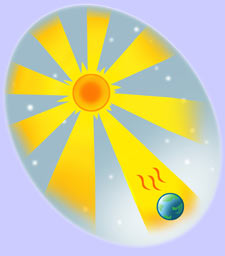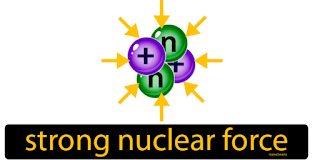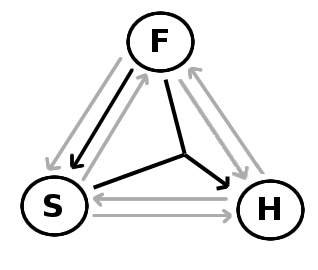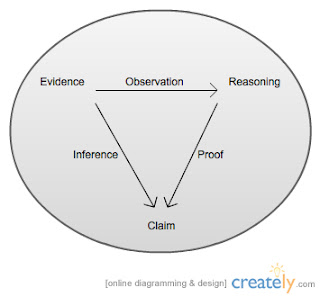By G J Gillespie
“Nothing exists except atoms and empty space; everything
else is opinion.” -- Democritus (460 -- 370 BCE)
The fact that the universe is intelligible permits
scientific discoveries. Scientists apply reasoning
to discover physical laws that govern our universe -- such as Isaac Newton’s inverse square law of gravity
(the closer you get to a point, the stronger the force). Usually truths that
advance culture are established only after a long period of debate among the
experts who fight over various proposals and hypotheses until a majority acquiesce. The ability to debate
is an essential part of what it means to be human. We question accepted ways of
doing things. We argue over ideas to shape the direction of our future. We present interpretations of what is
observed, until others offer better explanations.
The controversial theories of Newton were
vigorously challenged by his opponents at first. But, he was able
to prove his contentions by scientific experiments -- which became strong
evidence in support of the new perspectives.
Newton’s reasoning eventually led to the discoveries such as the steam
engine and electricity that made the industrial revolution possible. All social
progress follows a period of reasoned debate by advocates who are able to convince the majority to take a shared position.
More recently physicists have debated the nature of
fundamental particles, stellar objects and cosmic forces. The existence of
black holes, (Overbye) the Higgs Boson – the theorized “God particle” (Weinberg) -- and mysterious
dark matter and dark energy (Kahn) (thought to make up 95 percent of the universe)
spurred heated debate among cosmologists – until recent scientific experiments
confirmed that these properties actually do exist. Before the experimental
evidence gave weight to the theories experts were all over the map, each taking
a different stand. After the arguments were settled, most of these scientists
moved to occupy a single spot on the landscape of knowledge. It may be that
discoveries in quantum mechanics will lead to new technologies we might
currently find hard to even imagine.
 One contribution to the study of reason based on ancient
Greek and Roman teachers and developed in the twentieth century is the movement
metaphor. This is the belief that reasoned persuasion is best explained as
movement from diverse points on a plane to a single spot. To persuade an
audience is to move them closer to our position. We advance ideas to sway
others. Reasoning is a force we use to convince others. So, the comparison between an argument and physical
properties in space and time is natural.
One contribution to the study of reason based on ancient
Greek and Roman teachers and developed in the twentieth century is the movement
metaphor. This is the belief that reasoned persuasion is best explained as
movement from diverse points on a plane to a single spot. To persuade an
audience is to move them closer to our position. We advance ideas to sway
others. Reasoning is a force we use to convince others. So, the comparison between an argument and physical
properties in space and time is natural.
In advanced mathematics and physics,
the idea of an imaginary space is called a manifold. An object in a manifold
has a velocity that propels it across a plane from A to B. An arrow represents
the velocity. The distance between A and B is called the order of magnitude.
 We see that the geometrical concept of a manifold is very
much like an argument. An argument has a line of reasoning that is like the
arrow of velocity: A (support) - - > B (claim). Like gravity or the nuclear
force inside atoms, reasoning in an argument is the force that binds support to
the claim. Without the binding force of reasoning, the bits of supporting
material float chaotically -- appearing as random data that make no sense. When we add reasoning in the mix, the bits of
data cohere to form a pattern that makes sense. Children playbooks ask the
reader to connect dots to create a picture of a cat, horse or in this case, a goose. (Connect the Dots). Reasoning is
connecting the dots, pulling together bits of information to form a bigger picture. After hearing a persuasive argument, the audience will have an
“Ah-ha” moment. “Now I get it!”
We see that the geometrical concept of a manifold is very
much like an argument. An argument has a line of reasoning that is like the
arrow of velocity: A (support) - - > B (claim). Like gravity or the nuclear
force inside atoms, reasoning in an argument is the force that binds support to
the claim. Without the binding force of reasoning, the bits of supporting
material float chaotically -- appearing as random data that make no sense. When we add reasoning in the mix, the bits of
data cohere to form a pattern that makes sense. Children playbooks ask the
reader to connect dots to create a picture of a cat, horse or in this case, a goose. (Connect the Dots). Reasoning is
connecting the dots, pulling together bits of information to form a bigger picture. After hearing a persuasive argument, the audience will have an
“Ah-ha” moment. “Now I get it!”
The principle of connection in reasoning is like the
velocity of movement of physical objects in space. Reasoning channels the
energy in the support to propel an argument forward. The amount of ground that
is covered from A to B, that is, how firm the connection between the support
and the claim is established is the magnitude of an argument.
 |
| Wishing Well by GJ Gillespie |
Strong arguments have high magnitude – meaning that when
we add up a variety of
supporting evidence it leads us to accept the claim.
Just as high magnitude stars shine bright in our physical universe, so once we
hear a strong argument, it dominates our thinking. Opponents find strong
arguments difficult to dismiss, refute or ignore. We may look to the bright
ideas of a strong argument to guide our thinking, exactly as ship captains of
the past looked to the stars for navigation.
On the other hand, weak arguments have low magnitude, or
weak persuasive force. These are dim bulbs that fail to enlighten. The support
does not lead decisively to the claim. Just as the connections between the bits
of support along the line of reasoning in a strong argument are difficult to
break, a weak case is easy to tear apart. An opponent can point out that the
support is insufficient, flawed, or irrelevant. The reasoning in poorly
constructed arguments may be so fuzzy that the argument fails to make a clear
mental picture. The idea falls flat. The
audience is unmoved or maybe even confused.
Again, the simple model of an argument can be visualized
as the connection between two points on a two-dimensional plane: Support - -
> Claim.
We can add other more complex models of how arguments
flow. The chain model is a continuation of the simple model in which once a
claim has been proven, it functions as support for a larger claim one after
another. Each point is logically connected and builds on the point before.
Support - - > Support - - > Claim
The cluster model is a collection of independent reasons
that each lends support for the claim.
Support - - > Claim < - - Support
If it is true that persuasion is like momentum in space and time perhaps we might apply other physical laws to rhetoric as
well? Let us take the movement metaphor deeper by comparing reasoning to physical forces.
 Reasoning as Force in Argument Space
Reasoning as Force in Argument Space
A force in physics is said to be the strength or energy
that causes an object to undergo a change in speed, direction, or shape. There are four fundamental forces that govern
the universe: gravity, electromagnetism, weak nuclear and strong nuclear. These forces rule how planets, moons, stars
and galaxies interact.
Similarly there are four fundamental forces that bind
points together in argument space: reasoning by generalization, analogy,
cause-effect and authority. Like
physical laws, each force of reasoning also has logical laws and rhetorical
principles that we can use to predict the persuasiveness of an argument based
on them.
Modern rhetorician Richard Weaver lists the four types in a
hierarchy from the most ethical to the least ethical.
Argument from:
1. genus or generalization.
2. similitude or analogy.
3. circumstance or cause and effect.
4. testimony or authority. (Weaver)
Starting with the weakest and moving
to the strongest form of reasoning, let us consider how each compares to the fundamental forces.
 |
| Nocturnum by GJ Gillespie |
Gravity is like Authority
Gravity in the physical universe is a force that pulls
matter together. It shrinks the distance between objects. The
more mass of an object, the stronger the gravitational pull it exerts. The
effects of gravity also depend on proximity since attraction increases the nearer you are to a massive
object. This is known as the inverse square law: the intensity is inversely proportional to the distance from the source. Even though the sun is one
million, three hundred thousand times larger than the earth, we are held to the
ground by the earth’s gravity because we are closer to the earth.
In the argument universe, reasoning also is a force that
pulls debate matter together. The first example of the pull of reasoning
between forms of supporting matter we will consider is reasoning by authority.
These are arguments which rely on the strength of a trusted external
source.
We might say that the pull of authority in the rhetorical
universe is like gravity in the cosmos.
Ideas that are shared by credible authorities possess
persuasive weight for listeners. When an audience hears testimony from experts
or eyewitnesses, or is given the conclusions of published scientific studies,
their thinking will move closer to the position advocated. Just as the inverse square rule of physics
shows that proximity increases force, the closer an audience is to the position
of an authority, the stronger the persuasive force. If the authority is
perceived as a role model or is highly respected, an audience will find it difficult to dismiss.
Reasoning by authority draws upon collective wisdom of
philosophers or sages in producing artifacts like sacred scripture or founding
political documents such as the Constitution or Bill of Rights. The sway of cultural authorities (religious
leaders, artists, writers, sports or film stars) is especially powerful. The
findings by scientists in published studies using the scientific method may be
inescapable. Like the effects of gravitational fields spreading across the
cosmos, reasoning by authority is a pervasive force across the argument
universe. If authorities are on your
side, you will probably win the debate.
However, an advocate who simply cites an authority and is
done with it -- who fails to provide other arguments to back up a claim -- will
probably have a very weak persuasive impact. Because Weaver believed that
"an argument based on authority is as good as the authority," he
placed authority as the weakest argument type in his hierarchy. (Johannesen)
Similarly physicists say that gravity is the weakest of
the four fundamental forces. Out of the
millions of celestial objects floating in space a smaller body must be close to
a more massive object before the force of gravity is felt. In the same way,
audience members must be close to the authority who is recognized to have
persuasive weight. In other words, he or she must already be in the orbit or
pull of that authority's influence.
While we are familiar with the force of gravity in our
everyday lives, a second fundamental force is invisible to us. Yet it turns out
to be essential for our very existence.
 Analogy is like Weak Nuclear Force
Analogy is like Weak Nuclear Force
Second, let’s consider how weak nuclear force is similar to
reasoning by analogy and the creation of original metaphors.
According to physicist Micahio Kaku, the weak nuclear
force is
“responsible for radioactive decay. Because the weak
force is not strong enough to hold the nucleus of the atom together, it allows
the nucleus to break up or decay. Nuclear medicine in hospitals relies heavily
on the nuclear force. The weak force also helps to heat up the center of the
Earth via radioactive materials, which drive the immense power of volcanoes.
The weak force, in turn, is based on the interactions of electrons and
neutrinos (ghost-like particles that are nearly massless and can pass through
trillions of miles of solid lead without interacting with anything). These
electrons and neutrinos interact by exchanging other particles, called W and Z
bosons.” (Kaku)
In addition to permitting subatomic particles to interact
and release energy, Kaku says the weak nuclear force causes the fusion that
fires the sun and stars. Just as the weak force causes light to shine making it
possible to see around us, an apt analogy in an argument is enlightening. While
light is actually part of the electromagnetic spectrum; it has its source in
the weak force. When the landscape is dark, travelers can look to stars in the
night skies as glimmering points of navigation. In the same way, analogies are
points in the rhetorical skies that guide our thinking – especially when an
audience is unsure.
Without the weak force human life on earth would be
impossible. Likewise since "all language is metaphorical," without
metaphor and analogy language would be impossible. When we consider how new
metaphors are generated we see more similarities between reasoning by analogy
and the weak force.
 |
Infinity by GJ Gillespie
|
Quantum tunneling is like an analogy or metaphor in that
the persuasive energy in one body of matter “crosses over” to another unrelated
body of matter. Normally an impenetrable barrier of logic separates the two
material objects being compared since there is a literal difference. Like a
person walking through a wall, or ghostly neutrinos shooting through miles of
solid lead, original metaphors do the impossible. They spark never before heard
of insight.
The weak force is said to permit “quantum tunneling”, the strange ability for particles to jump through otherwise impenetrable barriers. Electronics applies the principle in the working of transistors for radios and diodes in television screens. According to quantum mechanics, matter exists as both a wave and particle. This is the wave-particle duality. One interpretation of quantum tunneling is that particles are able to pass through barriers in the form of waves of energy. Once crossing over, the energy on the other side is the same, but the amplitude (power) is reduced.
Reasoning by analogy permits the rhetorical energy
(meaning) to jump the barrier of logic by relating the two objects
figuratively. The persuasive energy now flowing in the second object follows
the same recognizable pattern that exists in the first -- although the
amplitude is reduced, making analogy a weak form of argument. No one is forced
to accept it -- although they may be more willing to listen to our other
arguments.
Some destinations are so distant from the position of the
audience that we must inspire them to follow where our line of reasoning leads.
It may take a creative analogy to make them receptive. In this way, analogy in our argumentation may
be a kind of “quantum tunneling” that transports our ideas through the thickest
mental defensive walls.
While the logical jump made by the analogy may generate a
persuasive insight for the audience, they are not bound to accept it. Analogy
lacks the binding force of a literal comparison in an example. The persuasive
power of analogy and metaphor comes from generating what Kenneth Burke calls
“perspective by incongruity”. (Burke) An apt metaphor gives new thought
patterns that surpass everyday thinking and inspires emotional support for
accepting an argument.
Consider: “My love is a red, red rose.” There is a
logical barrier between “a rose” and the “my love”. Reasoning by analogy
bridges the barrier with emotional energy. The same wave pattern in a rose is
transferred to the love, which is now understood differently by the viewer
exposed to the analogy.
The tentative nature of analogy makes it the next weakest
form of argument after relying on authority alone. It is always
possible to point out false elements in any comparison or to offer competing
analogies for opposite positions. Logic does not force an audience to follow the direction that an analogy implies. They are
free to reject it in favor of a competing analogy. Similarly, physicists say
that the weak nuclear force has a field strength that has less magnitude
compared to other fundamental forces. The weak force is said to be
unable to produce “bound states” and lacks “binding energy” necessary to force
objects together at the atomic level.
Analogies at best are ways for catching attention and framing an issue, useful for winning over the heart of an audience. Subtlety may be exactly what is needed. Just as the weak nuclear force is responsible for earthquakes by heating up the molten core of the earth, so an inspirational analogy is able to shake up thinking.
 |
| Map to Gilead by GJ Gillespie |
Cause and Effect is like Electromagnetism
Third, we can compare the fundamental force of
electromagnetism to reasoning by cause and effect. The essential characteristic of causation is
the idea of movement between related materials.
Showing that something is caused by a related effect in a sequence
produces the power of the argument.
We show that when one thing is observed, it is followed
by another thing in such a way that the first caused the second. We can speak
of a"chain of causation" to explain how complex events emerge. One
thing leads to another and to another. Persuasive force is therefore generated
by showing a relationship between cause and effect. In other words, the energy
of our thinking moves from the cause to the effect to a conclusion that we are
trying to prove.
An advocate is using cause – effect reasoning when he or
she argues that because people exposed to secondhand smoke have higher rates of
lung disease, secondhand smoke causes lung disease. Thus, smoking should be
discouraged. We can see a flow of
rhetorical energy from the cause (breathing secondhand smoke) to the effect
(lung disease) leads the audience to accept our claim that smoking should be
curtailed.
This flow of mental energy is similar to the physical
force of electromagnetism. Electricity can be explained as the flow of
electrons or energy between groups of related matter. We know that every atom has an electron
cloud. The electrons sometimes break free and move to other atoms meaning that
electricity is basically the movement of energy. Inventor Thomas Edison defined
it as "a mode of motion" between charged particles.
The force of cause and effect can in the same way
“charge” the matter of our arguments, filling them with persuasive energy. Just
as electricity is the movement of particles that possess either negative or
positive charges, so in a debate our points will be positive or negative –
positive matter seeks to attract the thinking of the audience to your position,
while negative matter seeks to repel them from the position of your
opponent. Likewise, the atoms in the
matter of magnetized objects are lined up, creating a magnetic field that can
attract or repel.
While other forms of reasoning besides cause and effect
can also be used to create positive and negatively charged matter in a debate,
when a debater wins causation arguments, he or she can be assured that the
thinking of the adjudicators will be lined up with their own. Causation in this
sense is a persuasive force that binds your arguments together to make them
receptive to the minds of the audience.
Usually we speak of causal relationships as increases in
probabilities rather than absolute links. Rarely do we know for certain that
one event is caused directly by another. Instead, a debater is on firmer ground
to say that the there is an increased probability of the relationship holding
true. Smoking increases the probability of cancer. We say that rhetoric (or
persuasion) is concerned with probabilities and logic is concern with
certainty.
A type of logic called a syllogism can prove the
certainty of a conclusion. If the premises are true, we can be certain of the
conclusion. All men are mortal. Socrates was a man. Therefore, Socrates was
mortal. If the premises (all men are mortal and Socrates was a man) are true,
we are certain of the conclusion (Socrates was mortal). Again, the energy of
the premises flow to the conclusion.
However, most controversies that are debated are unlike
classical syllogisms. Most of the time we can only get the audience to agree
that more than likely, or probably, we are giving them the best explanation or
plan of action. We can not be certain, but we arrive at a level of probability
good enough to take action.
The probabilistic nature of cause and effect reasoning is
analogous to physics, since quantum mechanics – the study of how energy works
on the subatomic level – is governed by what is called the “uncertainty
principle”. The uncertainty principle says that we can never be certain of the
position of an electron. Physicists can make a good guess where the electrons
will most likely be present, but they cannot say exactly. Physicists have a choice: either they can
measure where an electron is or how fast it is, but not both at the same time.
We are inherently uncertain about the quantum realm of the subatomic world. In
the same way, when it comes to predicting the future or measuring the
relationship between what causes effects to occur, we are never certain. The
best we can get when debating social policy is statistical probability. Again
we find a parallel between the forces of reasoning and the forces of nature –
which makes sense since our minds are part of nature.
Generalization is like Strong Nuclear Force
F
inally we turn to the fourth fundamental force, the
strong nuclear, and compare it to
reasoning by generalization. Strong nuclear
force is what holds atoms together. It binds protons and neutrons to form the
nucleus of an atom. On a smaller scale, the strong force also binds the
subatomic particles (quarks and gluons) that make up protons and neutrons. It is the strongest of all physical forces.
When this atomic bond is broken it results in an explosion of massive energy --
utilized by nuclear power as well as weapons.
In terms of argument space, just as the strong force
holds matter together in the physical universe, so generalization holds our
arguments together. And according to Weaver, generalization -- or argument by
what he calls genus -- is the strongest argument type.
There are two ways an advocate might reason by
generalization: setting down key terms or philosophical principles, and by
giving examples of a general class. By
referring to general principles or values favored by an audience, the advocate
draws them to accept a specific case.
For example: a speaker might appeal to such values as "All men are
created equal," or "Democratic forms of government are
best". Then he or she might say: We know that slavery is wrong
because all men are created equal. Or: We oppose dictatorships because
democratic systems are ideal.
Pointing out that a case supported by universal moral
principles is a form of deductive reasoning. The debater draws conclusions
based on larger premises already accepted by the audience. Once the
premise is accepted, the conclusion follows. Poet Ralph Waldo Emerson once
said: "Now that is the wisdom of a man, in every instance of his labor, to
hitch his wagon to a star, and see his chore done by the gods themselves."
Debaters will likewise hitch their wagon to the star of great moral principles
and let the force of those truths win the day. (Emerson)
Besides looking to lasting principles, the second way
that a speaker makes a generalization is by citing typical examples that
illustrate the general idea. Generalization by example works like this: say I
have a sack of apples hidden from my view. If I reach into the sack and
randomly select an apple to examine it and discover that the apple is rotten, I
will generalize that all of the apples in the sack are rotten. Examples that
illustrate a larger group are powerful.
The most effective speakers know that vivid examples and
dramatic stories are at the heart of argument. Until it is clear to an audience
that people are affected by some larger harm, it will be difficult to persuade
them to accept a solution. For example, why should we curtail video games?
Because it hurts the psychological development of children. While this point
could be supported with a statistic or scientific study, examples of harmed
children will add emotional weight to the argument. To make the point
memorable, a speaker could tell the story of specific children harmed by video
games. In this way stories embody a thesis.
In addition to individual examples to support a larger
point, we can look to the structure of a story or drama to organize our
analysis. Narrative structure follows a theme. A theme is a generally
recognized course of action among humans that is similar to what happens in a
drama or play. Themes form the basis for literary novels and films.
Usually a dramatic theme follows this pattern: A victim
is being hurt. Good guys are trying to save the victim, but they must overcome
the action of the bad guys. Besides good versus evil, another theme might be
social progression – that society is gradually improving over time as old forms
of thinking are worn out and new ideas take hold. Dramatic themes like these
glue together all the supporting material forming an overarching narrative that
makes sense of the data for the audience, binding together all of the
particular elements of our persuasive matter – just as the strong nuclear force
binds the subatomic particles of physical matter.
Communication scholar Walter Fisher proposed the
narrative paradigm of argument, claiming that all meaningful communication is a
form of storytelling. He contends that "since human beings comprehend life
as a series of ongoing narratives, each with their own conflicts, characters,
beginnings, middles, and ends, arguments will also follow a narrative pattern.
An argument is essentially a story." (Fisher)
 Storytelling, then, is the atomic bond that makes the
composite information in our speech cohere.
Storytelling, then, is the atomic bond that makes the
composite information in our speech cohere.
Quest for the Dark Matter of Argument
Overall, the four types of reasoning compose the universe
of ideas just as fundamental forces shape time, space, planets, and stars. Still, mastering the techniques of argument
making may never be enough to automatically pull an audience into our sphere.
Persuasion is a mysterious art rather than a precise science. With the advent
of quantum mechanics scientists are also learning that reality is more
mysterious than once imagined.
Physicists recently have discovered that the cosmos
contains more mass than is accounted for by visible matter that we see around
us. Most cosmologists have come to believe that visible matter is only about 5
percent and that 95 percent of the mass of the universe is made of “dark matter
and dark energy.” Dark matter may be
based on a new kind of physics we have never experienced.
We could apply the concept of dark matter to public debate
when we realize that what is said -- the matter that is exchanged in the
communication between speakers and listeners -- is only a small part of the
force that influences how an audience comes to believe. Most of the pull on our
thinking is from unconscious information and cultural values that an audience
brings to the setting. A speaker trying to influence an audience will take into
account the weight of the “dark matter” of unconscious presuppositions and
cultural values by lining up his or her arguments with the unstated assumptions
hovering in the room. Harnessing this dark matter may require setting aside
analytical reasoning in favor of intuition, creativity and poetry.
In summary we see that expanding the movement metaphor to
include a comparison between physical forces and types of reasoning gives
insight into how persuasion works. Just as the discovery of the four
fundamental forces led to practical technologies like the steam engine, the
electric light, transistors, and x ray photography applying these analogies
from physics to rhetoric will aide our persuasiveness.
•Like
falling into a gravitational field of a celestial body, taking the side of
authorities near to the heart of the audience will make arguments difficult to
resist.
•Like
quantum tunneling, apt analogies, creative metaphors and comparisons have the
surprising ability to break through walls of resistance, permitting an audience
to see the light of our perspective.
•Like
a jolt of electricity, revealing the chain of cause and effect that make up a
controversy will charge our case with power.
•And,
like nuclear forces inside atoms, tying our case to universal principles --
justice, equality or freedom -- and by storytelling -- we will strengthen the
binding force of ideas.
With the continued promise of new discoveries, there are
countless more comparisons between physics and the human mind. As nuclear
physicist Isidor Rabi predicted:
“I don’t think that physics will ever have an end. I
think that the novelty of nature is such that it’s variety will be infinite –
not just in changing forms but in the profundity of insight and the newness of
ideas.” (Rabi)
Citations
Democritus, Stanford Encyclopedia of Philosophy, (date
accessed: July 23, 2012, < http://plato.stanford.edu/entries/democritus/
> )
Overbye, Dennis, "Astronomers Discover Biggest Black Holes Yet", New York Times, December 5, 2011. (Date accessed: July 26, 2012, < http://www.nytimes.com/2011/12/06/science/space/astronomers-find-biggest-black-holes-yet.html >)
Weinberg, Steven, "Why the Higgs Boson Matters", New York Times, July 13, 2012. (Date accessed July 26, 2012. < http://www.nytimes.com/2012/07/14/opinion/weinberg-why-the-higgs-boson-matters.html?_r=1&pagewanted=all >)
Kahn, Amina, "Dark Matter Filament Found, Scientists Say, Los Angeles Times, July 4, 2012. (Date accessed: July 24, 2012. < http://articles.latimes.com/2012/jul/04/science/la-sci-dark-matter-filament-20120705 > )
Weaver, Richard, The Ethics of Rhetoric. Chicago: Henry
Regnery Company, 1953. 56.
Johannesen, Richard L., Rennard Strickland, & Ralph
T. Eubanks, Eds. Language Is Sermonic: Richard M. Weaver on the Nature of
Rhetoric. Baton Rouge: Louisiana State UP, 1970. 216.
Kaku, Michio, Parallel Worlds, A Journey Through
Creation, Higher Dimensions, and the Future of the Cosmos, Anchor Books, A
Division of Random House, Inc, New York, 2005. 80.
Burke, Kenneth,
Permanence and Change: An Anatomy of Purpose, Los Altos, CA: Hermes
Publications, 1954.
Emerson, Ralph Waldo, The Atlantic Monthly; April 1862;
American Civilization - 1862.04; Volume IX, No. 54. 502-511
Fisher, Walter R. Human Communication as Narration:
Toward a Philosophy of Reason, Value, and Action. Columbia: University of South
Carolina Press, 1989.
Rabi, Isidor -- cited in Zukav, Gary, The Dancing Wu Li
Masters, Harper Collins, 1979.
345.























